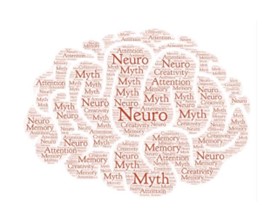D. Otros neuromitos

Aparte de los estudios aplicados por Grospietsch y Mayer (2018 , 2019 , 2021a , b y Grospietsch 2019) para proporcionar una clarificación científica (Kattmann et al., 1997 ) de los neuromitos antes mencionados, existen pocas descripciones teóricas adicionales de otros neuromitos (por ejemplo, en Jarrett, 2014; Beck, 2016a ; Tokuhama-Espinosa, 2018). Por ejemplo existe el <a class="glossaryLink" aria-describedby="tt" data-cmtooltip="
Neuromyth
A misconception generated by a misunderstanding, a misreading, or a misquoting of facts scientifically established (by brain research) to make a case for the use of brain research in education and other contexts
" href="https://elearn.neuropedagogy.upatras.gr/el/glossary/neuromyth/" data-gt-translate-attributes="[{"attribute":"data-cmtooltip", "format":"html"}]" target="_self">neuromito de que usamos solo el 10% de nuestro cerebro. Según Grospietsch y Mayer (2019) , el núcleo de verdad que subyace a este <a class="glossaryLink" aria-describedby="tt" data-cmtooltip="Neuromyth
A misconception generated by a misunderstanding, a misreading, or a misquoting of facts scientifically established (by brain research) to make a case for the use of brain research in education and other contexts
" href="https://elearn.neuropedagogy.upatras.gr/el/glossary/neuromyth/" data-gt-translate-attributes="[{"attribute":"data-cmtooltip", "format":"html"}]" target="_self">neuromito es que las técnicas de imagen contemporáneas pueden mostrar qué regiones específicas del cerebro están involucradas en ciertas actividades mentales o físicas. Por ejemplo, existen muchas imágenes de resonancia magnética funcional en las que solo se resalta en color una parte del cerebro.Otro <a class="glossaryLink" aria-describedby="tt" data-cmtooltip="
Neuromyth
A misconception generated by a misunderstanding, a misreading, or a misquoting of facts scientifically established (by brain research) to make a case for the use of brain research in education and other contexts
" href="https://elearn.neuropedagogy.upatras.gr/el/glossary/neuromyth/" data-gt-translate-attributes="[{"attribute":"data-cmtooltip", "format":"html"}]" target="_self">neuromito que tiende a ser descrito en la investigación sobre los conceptos (erróneos) de los estudiantes es la existencia de lugares de almacenamiento específicos (disco duro) en el cerebro (cf. Schletter y Bayrhuber, 1998 ). Según Grospietsch (2019) , el núcleo de verdad que subyace a este <a class="glossaryLink" aria-describedby="tt" data-cmtooltip="Neuromyth
A misconception generated by a misunderstanding, a misreading, or a misquoting of facts scientifically established (by brain research) to make a case for the use of brain research in education and other contexts
" href="https://elearn.neuropedagogy.upatras.gr/el/glossary/neuromyth/" data-gt-translate-attributes="[{"attribute":"data-cmtooltip", "format":"html"}]" target="_self">neuromito es que el cerebro contiene varias regiones corticales con una división funcional de tareas. También existe un <a class="glossaryLink" aria-describedby="tt" data-cmtooltip="Neuromyth
A misconception generated by a misunderstanding, a misreading, or a misquoting of facts scientifically established (by brain research) to make a case for the use of brain research in education and other contexts
" href="https://elearn.neuropedagogy.upatras.gr/el/glossary/neuromyth/" data-gt-translate-attributes="[{"attribute":"data-cmtooltip", "format":"html"}]" target="_self">neuromito sobre la existencia de periodos de tiempo críticos para el aprendizaje . El núcleo de verdad que subyace al <a class="glossaryLink" aria-describedby="tt" data-cmtooltip="Neuromyth
A misconception generated by a misunderstanding, a misreading, or a misquoting of facts scientifically established (by brain research) to make a case for the use of brain research in education and other contexts
" href="https://elearn.neuropedagogy.upatras.gr/el/glossary/neuromyth/" data-gt-translate-attributes="[{"attribute":"data-cmtooltip", "format":"html"}]" target="_self">neuromito sobre los períodos de tiempo críticos para el aprendizaje ( Howard-Jones, 2010 ;Adey y Dillon, 2012 ; Tokuhama-Espinosa, 2018 ), según Grospietsch y Mayer (2020) , es que ciertas cosas se pueden aprender más fácilmente durante determinadas fases sensibles durante la infancia ( Thomas y Johnson, 2008 ; Carter, 2014 ).